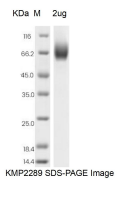Human CD47 Protein, mFc Tag
-
产品编号
KMP2289
-
别名
整联蛋白相关蛋白, Leukocyte Surface Antigen CD47, MER6
-
规格
- 50ug
- 100ug
- 200ug
| Alias | 整联蛋白相关蛋白, Leukocyte Surface Antigen CD47, MER6 |
| Catalog Number | KMP2289 |
| Product Description | The Human CD47 Protein(KMP2289) is produced in HEK293 Cells and the target gene encoding Gln19-Pro139 is expressed with a mFc tag at the C-terminus. |
| Molecular Name | CD47 |
| Species | Human |
| Host | HEK293 Cells |
| Size | 50ug, 100ug, 200ug |
| Purity | >95% as determined by SDS-PAGE |
| Purification | Affinity purification |
| Endotoxin | <1.0 EU/ug determined by the LAL method |
| Formulation | PBS, pH7.4 |
| Background | CD47(Integrin-Associated Protein,IAP) is a 40 - 60 kDa variably glycosylated atypical member of the immunoglobulin superfamily. The ubiquitously expressed CD47 binds to SIRP family members on macrophages, neutrophils, and T cells. CD47 is involved in the increase in intracellular calcium concentration that occurs upon cell adhesion to extracellular matrix. The protein is also a receptor for the C-terminal cell-binding domain of thrombospondin, and it may play a role in membrane transport and signal transduction. This protein has broad tissue distribution, and is reduced in expression on Rh erythrocytes. |
| SDS-PAGE |  |
| Predicted Molecular Weight | 14.72 kDa |
| Storage Condition | Aliquot and store at -20℃ to -80℃. Avoid repeated freezing and thawing cycles. |
| Shipping Condition | In general, the proteins are provided as lyophilized powder which are shipped at ambient temperature. They are shipped out in dry ice if supplied in liquid form. |
| Uniprot ID | Q08722#function |
| References | 1.J. Immunol. 167:2547-2554 (2001) 2.Blood 105:2421-2427 (2005) 3.J. Biol. Chem. 284:1116-1125 (2009) 4.Cardiovasc. Res. 113:15-29 (2017) 5.Cells 9:0-0 (2020) 6.J. Cell Biol. 123:485-496 (1993) 7.J. Biol. Chem. 271:21-24 (1996) |
| Function | Adhesive protein that mediates cell-to-cell interactions (PubMed:11509594, PubMed:15383453). Acts as receptor for thrombospondin THBS1 and as modulator of integrin signaling through the activation of heterotrimeric G proteins (PubMed:19004835, PubMed:8550562, PubMed:7691831). Involved in signal transduction, cardiovascular homeostasis, inflammation, apoptosis, angiogenesis, cellular self-renewal, and immunoregulation (PubMed:27742621, PubMed:19004835, PubMed:8550562, PubMed:11509594, PubMed:7691831, PubMed:32679764, PubMed:15383453). Plays a role in modulating pulmonary endothelin EDN1 signaling (PubMed:27742621). Modulates nitrous oxide (NO) signaling, in response to THBS1, hence playing a role as a pressor agent, supporting blood pressure (By similarity). Plays an important role in memory formation and synaptic plasticity in the hippocampus (By similarity). Receptor for SIRPA, binding to which prevents maturation of immature dendritic cells and inhibits cytokine production by mature dendritic cells (PubMed:11509594). Interaction with SIRPG mediates cell-cell adhesion, enhances superantigen-dependent T-cell-mediated proliferation and costimulates T-cell activation (PubMed:15383453). Positively modulates FAS-dependent apoptosis in T-cells, perhaps by enhancing FAS clustering (By similarity). Plays a role in suppressing angiogenesis and may be involved in metabolic dysregulation during normal aging (PubMed:32679764). In response to THBS1, negatively modulates wound healing (By similarity). Inhibits stem cell self-renewal, in response to THBS1, probably by regulation of the stem cell transcription factors POU5F1/OCT4, SOX2, MYC/c-Myc and KLF4 (By similarity). May play a role in membrane transport and/or integrin dependent signal transduction (PubMed:7691831). May prevent premature elimination of red blood cells (By similarity). |





 0
0
